The Significance of HR in Organizational Change Management
VerifiedAdded on 2022/09/16
|10
|2687
|31
Essay
AI Summary
This essay delves into the critical aspects of organizational change management, emphasizing the pivotal role of Human Resources (HR) as a change agent. It begins by defining change management and its importance in today's dynamic business environment, then analyzes both internal and external factors driving organizational change, such as political forces, market conditions, and technological advancements. The essay highlights the significance of senior managers in communicating change decisions and supporting employees through the transition. It also addresses the causes of resistance to change, providing insights into employee concerns and potential challenges. Furthermore, the essay outlines the steps to ensure an effective change process, including clear definition, communication strategies, training, and support structures. It concludes by discussing strategies for fostering a change-capable culture within an organization, emphasizing the importance of skills development, employee engagement, and a proactive approach to embracing change as a continuous opportunity for growth. The essay uses examples like Google's restructuring to illustrate the concepts.
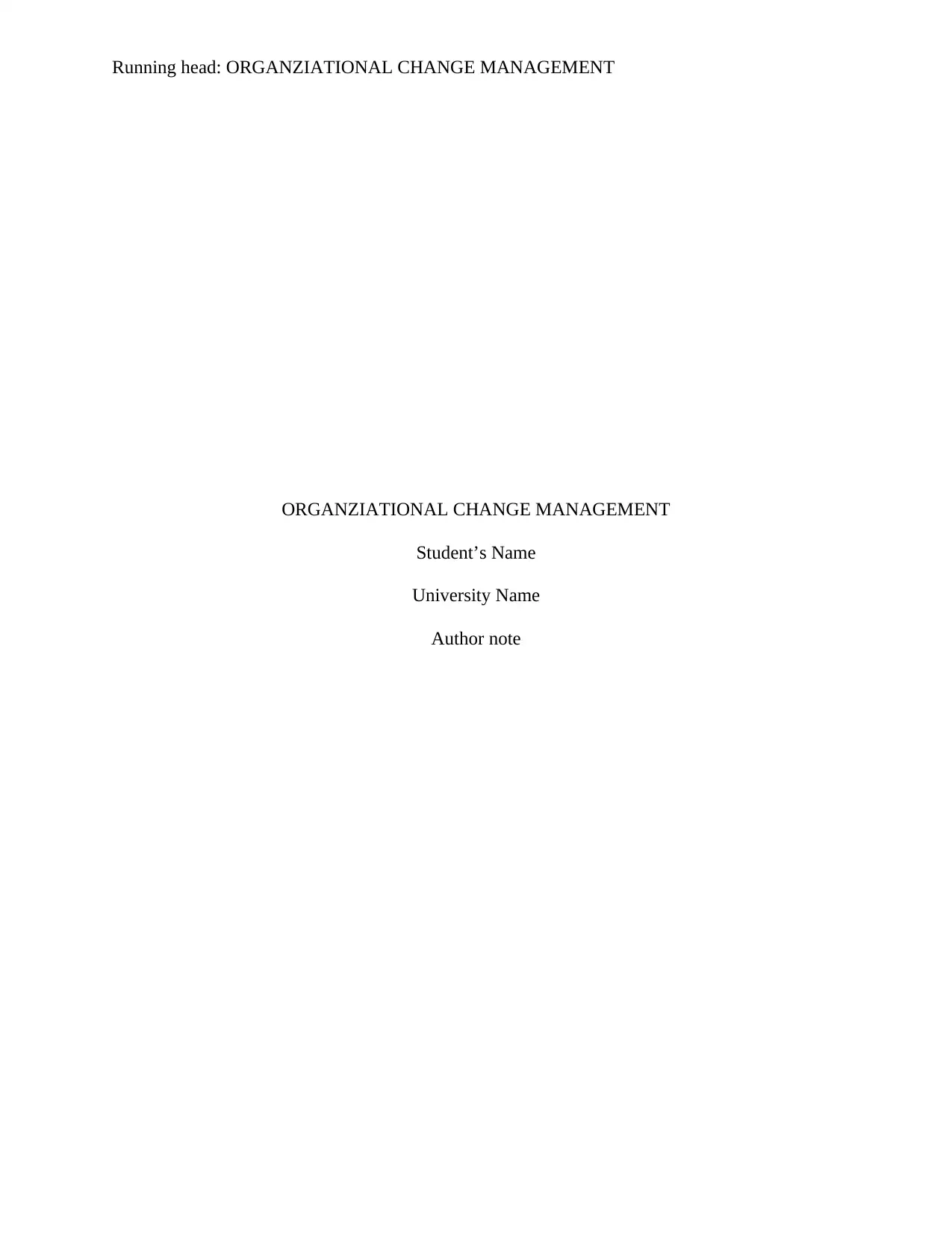
Running head: ORGANZIATIONAL CHANGE MANAGEMENT
ORGANZIATIONAL CHANGE MANAGEMENT
Student’s Name
University Name
Author note
ORGANZIATIONAL CHANGE MANAGEMENT
Student’s Name
University Name
Author note
Paraphrase This Document
Need a fresh take? Get an instant paraphrase of this document with our AI Paraphraser
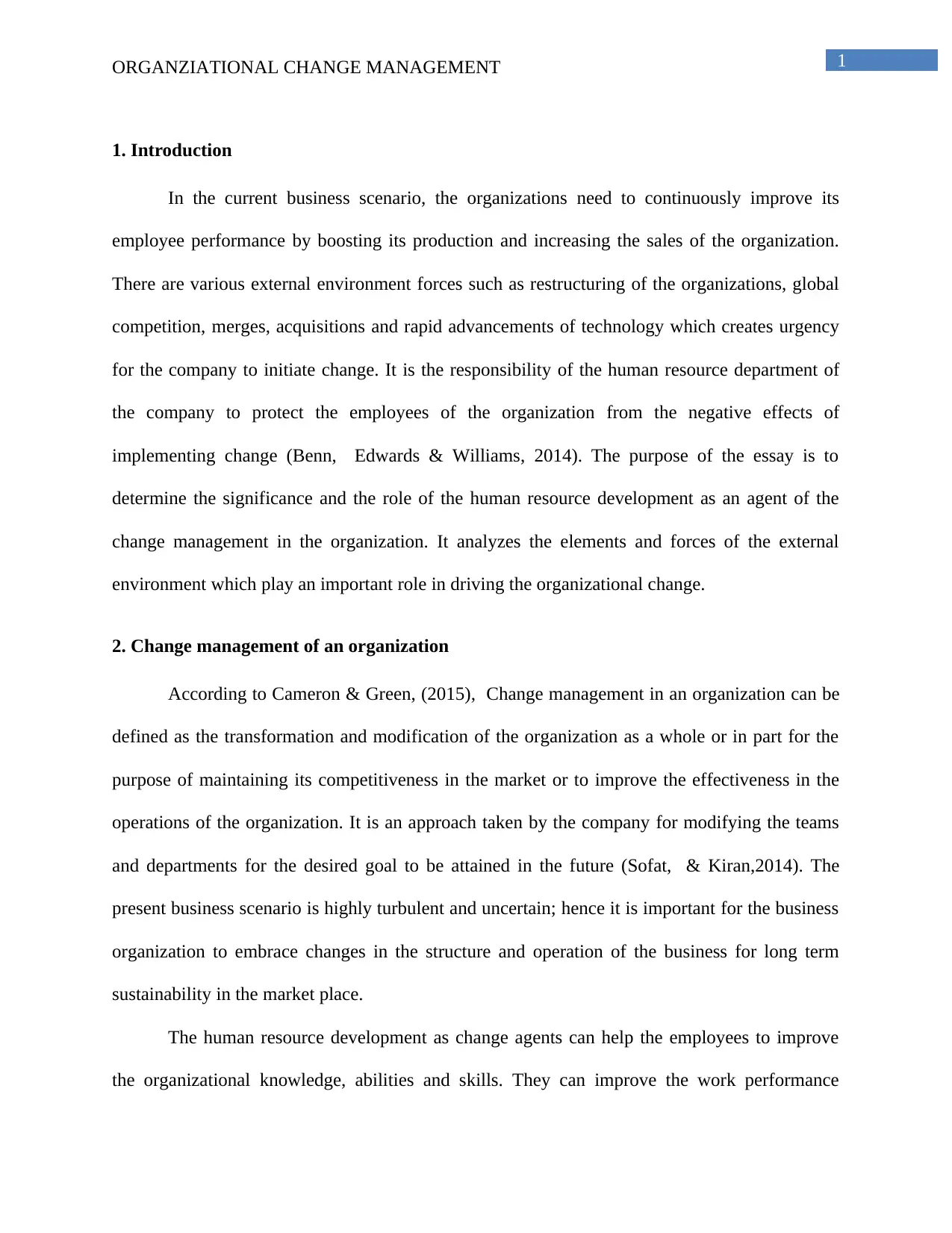
1ORGANZIATIONAL CHANGE MANAGEMENT
1. Introduction
In the current business scenario, the organizations need to continuously improve its
employee performance by boosting its production and increasing the sales of the organization.
There are various external environment forces such as restructuring of the organizations, global
competition, merges, acquisitions and rapid advancements of technology which creates urgency
for the company to initiate change. It is the responsibility of the human resource department of
the company to protect the employees of the organization from the negative effects of
implementing change (Benn, Edwards & Williams, 2014). The purpose of the essay is to
determine the significance and the role of the human resource development as an agent of the
change management in the organization. It analyzes the elements and forces of the external
environment which play an important role in driving the organizational change.
2. Change management of an organization
According to Cameron & Green, (2015), Change management in an organization can be
defined as the transformation and modification of the organization as a whole or in part for the
purpose of maintaining its competitiveness in the market or to improve the effectiveness in the
operations of the organization. It is an approach taken by the company for modifying the teams
and departments for the desired goal to be attained in the future (Sofat, & Kiran,2014). The
present business scenario is highly turbulent and uncertain; hence it is important for the business
organization to embrace changes in the structure and operation of the business for long term
sustainability in the market place.
The human resource development as change agents can help the employees to improve
the organizational knowledge, abilities and skills. They can improve the work performance
1. Introduction
In the current business scenario, the organizations need to continuously improve its
employee performance by boosting its production and increasing the sales of the organization.
There are various external environment forces such as restructuring of the organizations, global
competition, merges, acquisitions and rapid advancements of technology which creates urgency
for the company to initiate change. It is the responsibility of the human resource department of
the company to protect the employees of the organization from the negative effects of
implementing change (Benn, Edwards & Williams, 2014). The purpose of the essay is to
determine the significance and the role of the human resource development as an agent of the
change management in the organization. It analyzes the elements and forces of the external
environment which play an important role in driving the organizational change.
2. Change management of an organization
According to Cameron & Green, (2015), Change management in an organization can be
defined as the transformation and modification of the organization as a whole or in part for the
purpose of maintaining its competitiveness in the market or to improve the effectiveness in the
operations of the organization. It is an approach taken by the company for modifying the teams
and departments for the desired goal to be attained in the future (Sofat, & Kiran,2014). The
present business scenario is highly turbulent and uncertain; hence it is important for the business
organization to embrace changes in the structure and operation of the business for long term
sustainability in the market place.
The human resource development as change agents can help the employees to improve
the organizational knowledge, abilities and skills. They can improve the work performance
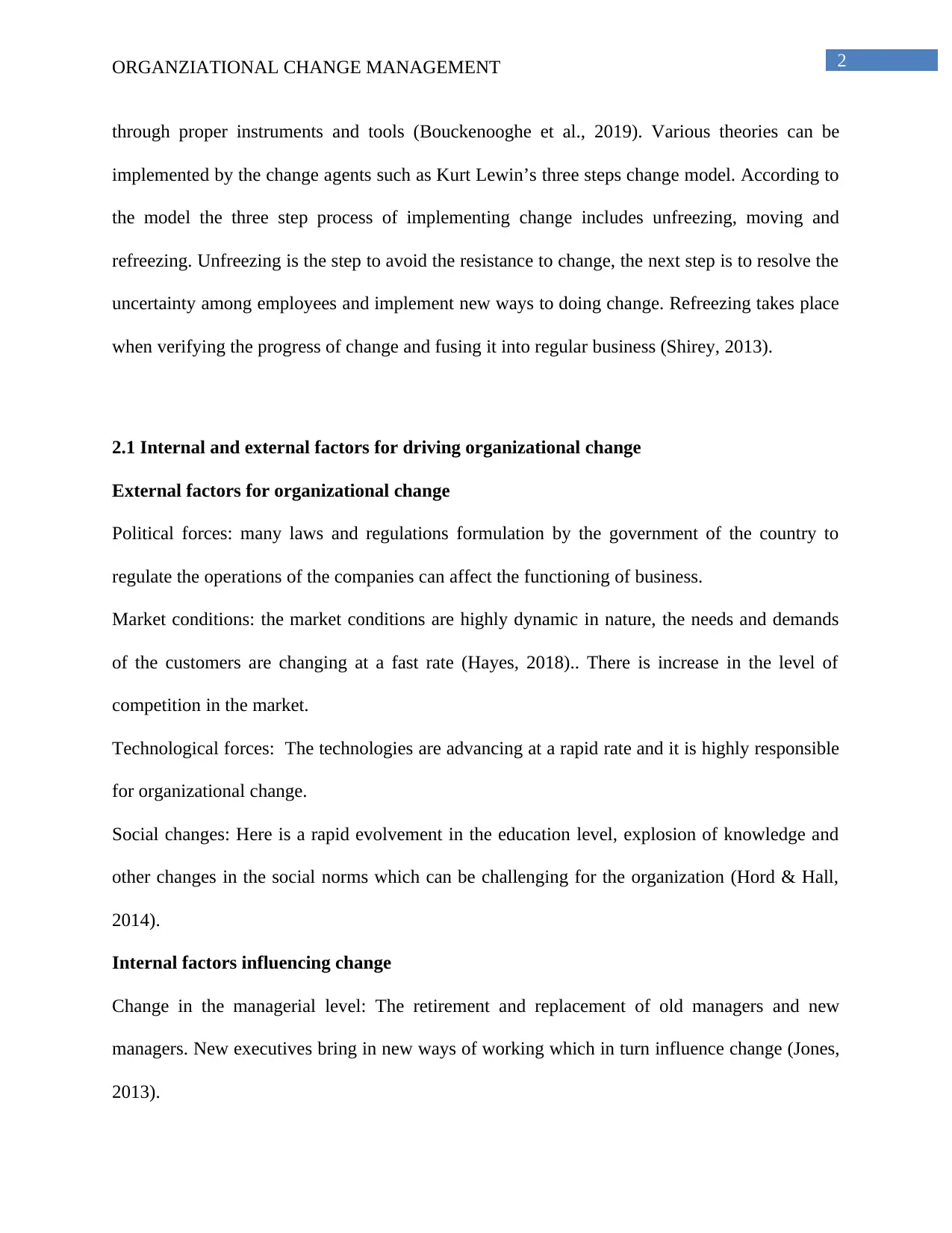
2ORGANZIATIONAL CHANGE MANAGEMENT
through proper instruments and tools (Bouckenooghe et al., 2019). Various theories can be
implemented by the change agents such as Kurt Lewin’s three steps change model. According to
the model the three step process of implementing change includes unfreezing, moving and
refreezing. Unfreezing is the step to avoid the resistance to change, the next step is to resolve the
uncertainty among employees and implement new ways to doing change. Refreezing takes place
when verifying the progress of change and fusing it into regular business (Shirey, 2013).
2.1 Internal and external factors for driving organizational change
External factors for organizational change
Political forces: many laws and regulations formulation by the government of the country to
regulate the operations of the companies can affect the functioning of business.
Market conditions: the market conditions are highly dynamic in nature, the needs and demands
of the customers are changing at a fast rate (Hayes, 2018).. There is increase in the level of
competition in the market.
Technological forces: The technologies are advancing at a rapid rate and it is highly responsible
for organizational change.
Social changes: Here is a rapid evolvement in the education level, explosion of knowledge and
other changes in the social norms which can be challenging for the organization (Hord & Hall,
2014).
Internal factors influencing change
Change in the managerial level: The retirement and replacement of old managers and new
managers. New executives bring in new ways of working which in turn influence change (Jones,
2013).
through proper instruments and tools (Bouckenooghe et al., 2019). Various theories can be
implemented by the change agents such as Kurt Lewin’s three steps change model. According to
the model the three step process of implementing change includes unfreezing, moving and
refreezing. Unfreezing is the step to avoid the resistance to change, the next step is to resolve the
uncertainty among employees and implement new ways to doing change. Refreezing takes place
when verifying the progress of change and fusing it into regular business (Shirey, 2013).
2.1 Internal and external factors for driving organizational change
External factors for organizational change
Political forces: many laws and regulations formulation by the government of the country to
regulate the operations of the companies can affect the functioning of business.
Market conditions: the market conditions are highly dynamic in nature, the needs and demands
of the customers are changing at a fast rate (Hayes, 2018).. There is increase in the level of
competition in the market.
Technological forces: The technologies are advancing at a rapid rate and it is highly responsible
for organizational change.
Social changes: Here is a rapid evolvement in the education level, explosion of knowledge and
other changes in the social norms which can be challenging for the organization (Hord & Hall,
2014).
Internal factors influencing change
Change in the managerial level: The retirement and replacement of old managers and new
managers. New executives bring in new ways of working which in turn influence change (Jones,
2013).
⊘ This is a preview!⊘
Do you want full access?
Subscribe today to unlock all pages.

Trusted by 1+ million students worldwide
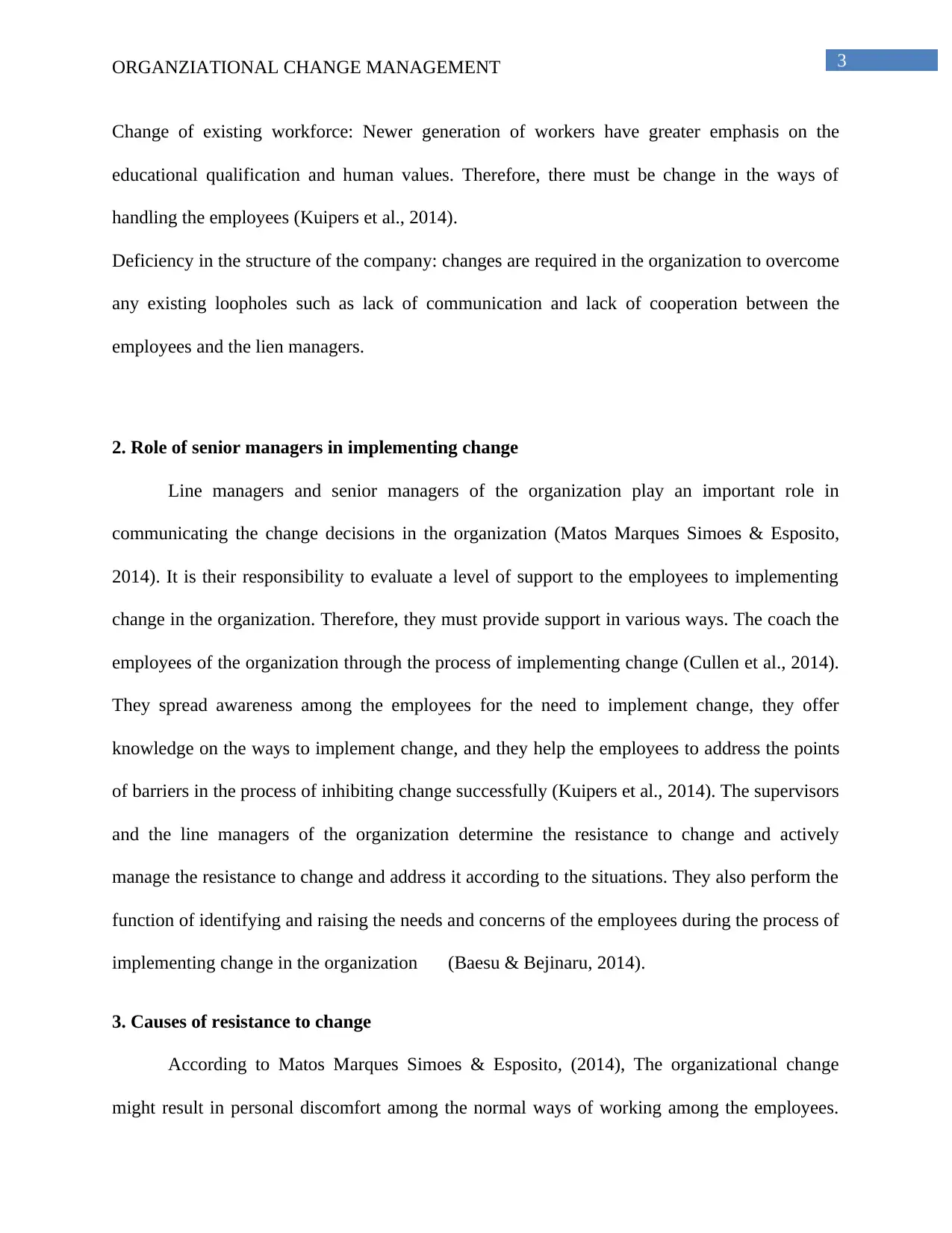
3ORGANZIATIONAL CHANGE MANAGEMENT
Change of existing workforce: Newer generation of workers have greater emphasis on the
educational qualification and human values. Therefore, there must be change in the ways of
handling the employees (Kuipers et al., 2014).
Deficiency in the structure of the company: changes are required in the organization to overcome
any existing loopholes such as lack of communication and lack of cooperation between the
employees and the lien managers.
2. Role of senior managers in implementing change
Line managers and senior managers of the organization play an important role in
communicating the change decisions in the organization (Matos Marques Simoes & Esposito,
2014). It is their responsibility to evaluate a level of support to the employees to implementing
change in the organization. Therefore, they must provide support in various ways. The coach the
employees of the organization through the process of implementing change (Cullen et al., 2014).
They spread awareness among the employees for the need to implement change, they offer
knowledge on the ways to implement change, and they help the employees to address the points
of barriers in the process of inhibiting change successfully (Kuipers et al., 2014). The supervisors
and the line managers of the organization determine the resistance to change and actively
manage the resistance to change and address it according to the situations. They also perform the
function of identifying and raising the needs and concerns of the employees during the process of
implementing change in the organization (Baesu & Bejinaru, 2014).
3. Causes of resistance to change
According to Matos Marques Simoes & Esposito, (2014), The organizational change
might result in personal discomfort among the normal ways of working among the employees.
Change of existing workforce: Newer generation of workers have greater emphasis on the
educational qualification and human values. Therefore, there must be change in the ways of
handling the employees (Kuipers et al., 2014).
Deficiency in the structure of the company: changes are required in the organization to overcome
any existing loopholes such as lack of communication and lack of cooperation between the
employees and the lien managers.
2. Role of senior managers in implementing change
Line managers and senior managers of the organization play an important role in
communicating the change decisions in the organization (Matos Marques Simoes & Esposito,
2014). It is their responsibility to evaluate a level of support to the employees to implementing
change in the organization. Therefore, they must provide support in various ways. The coach the
employees of the organization through the process of implementing change (Cullen et al., 2014).
They spread awareness among the employees for the need to implement change, they offer
knowledge on the ways to implement change, and they help the employees to address the points
of barriers in the process of inhibiting change successfully (Kuipers et al., 2014). The supervisors
and the line managers of the organization determine the resistance to change and actively
manage the resistance to change and address it according to the situations. They also perform the
function of identifying and raising the needs and concerns of the employees during the process of
implementing change in the organization (Baesu & Bejinaru, 2014).
3. Causes of resistance to change
According to Matos Marques Simoes & Esposito, (2014), The organizational change
might result in personal discomfort among the normal ways of working among the employees.
Paraphrase This Document
Need a fresh take? Get an instant paraphrase of this document with our AI Paraphraser
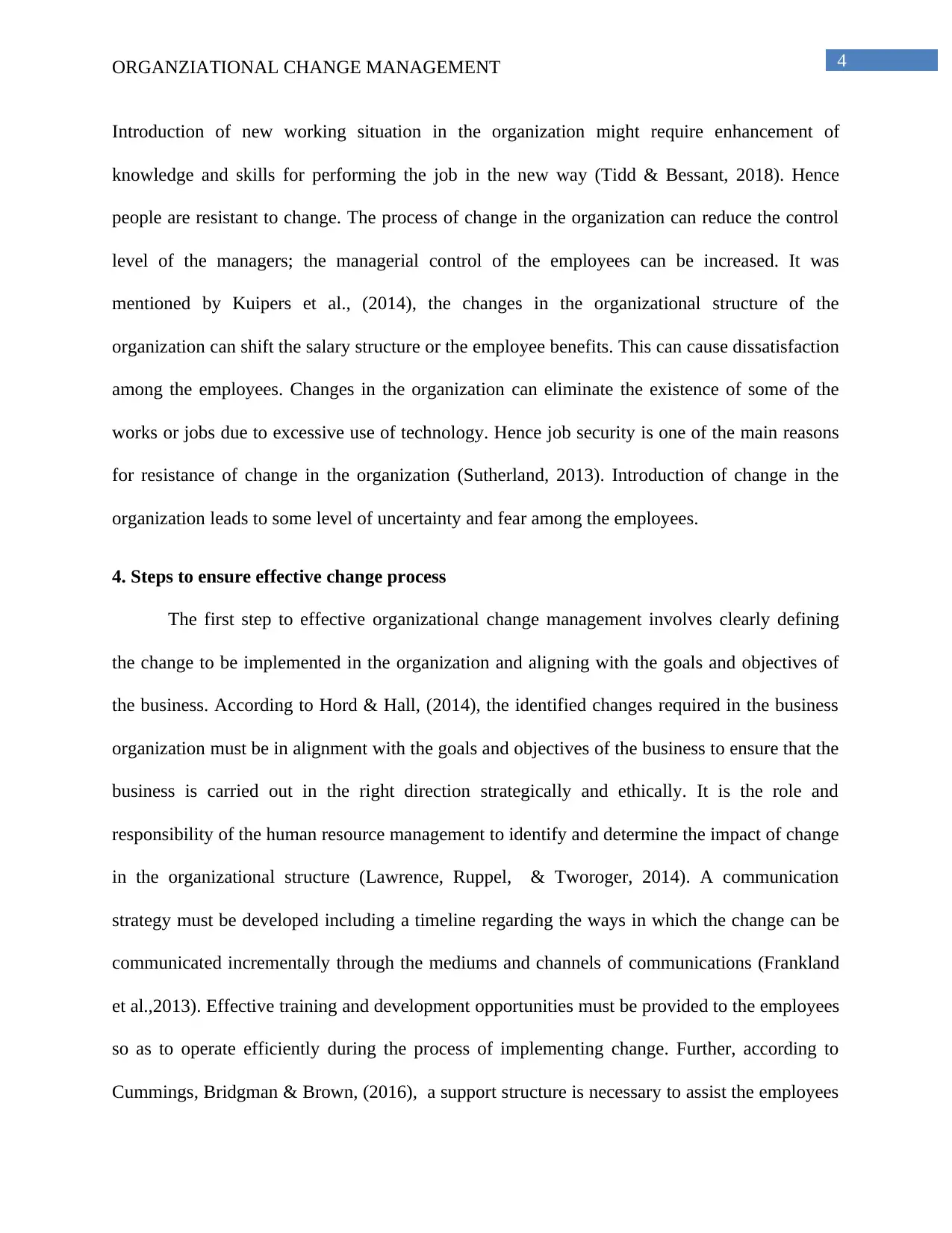
4ORGANZIATIONAL CHANGE MANAGEMENT
Introduction of new working situation in the organization might require enhancement of
knowledge and skills for performing the job in the new way (Tidd & Bessant, 2018). Hence
people are resistant to change. The process of change in the organization can reduce the control
level of the managers; the managerial control of the employees can be increased. It was
mentioned by Kuipers et al., (2014), the changes in the organizational structure of the
organization can shift the salary structure or the employee benefits. This can cause dissatisfaction
among the employees. Changes in the organization can eliminate the existence of some of the
works or jobs due to excessive use of technology. Hence job security is one of the main reasons
for resistance of change in the organization (Sutherland, 2013). Introduction of change in the
organization leads to some level of uncertainty and fear among the employees.
4. Steps to ensure effective change process
The first step to effective organizational change management involves clearly defining
the change to be implemented in the organization and aligning with the goals and objectives of
the business. According to Hord & Hall, (2014), the identified changes required in the business
organization must be in alignment with the goals and objectives of the business to ensure that the
business is carried out in the right direction strategically and ethically. It is the role and
responsibility of the human resource management to identify and determine the impact of change
in the organizational structure (Lawrence, Ruppel, & Tworoger, 2014). A communication
strategy must be developed including a timeline regarding the ways in which the change can be
communicated incrementally through the mediums and channels of communications (Frankland
et al.,2013). Effective training and development opportunities must be provided to the employees
so as to operate efficiently during the process of implementing change. Further, according to
Cummings, Bridgman & Brown, (2016), a support structure is necessary to assist the employees
Introduction of new working situation in the organization might require enhancement of
knowledge and skills for performing the job in the new way (Tidd & Bessant, 2018). Hence
people are resistant to change. The process of change in the organization can reduce the control
level of the managers; the managerial control of the employees can be increased. It was
mentioned by Kuipers et al., (2014), the changes in the organizational structure of the
organization can shift the salary structure or the employee benefits. This can cause dissatisfaction
among the employees. Changes in the organization can eliminate the existence of some of the
works or jobs due to excessive use of technology. Hence job security is one of the main reasons
for resistance of change in the organization (Sutherland, 2013). Introduction of change in the
organization leads to some level of uncertainty and fear among the employees.
4. Steps to ensure effective change process
The first step to effective organizational change management involves clearly defining
the change to be implemented in the organization and aligning with the goals and objectives of
the business. According to Hord & Hall, (2014), the identified changes required in the business
organization must be in alignment with the goals and objectives of the business to ensure that the
business is carried out in the right direction strategically and ethically. It is the role and
responsibility of the human resource management to identify and determine the impact of change
in the organizational structure (Lawrence, Ruppel, & Tworoger, 2014). A communication
strategy must be developed including a timeline regarding the ways in which the change can be
communicated incrementally through the mediums and channels of communications (Frankland
et al.,2013). Effective training and development opportunities must be provided to the employees
so as to operate efficiently during the process of implementing change. Further, according to
Cummings, Bridgman & Brown, (2016), a support structure is necessary to assist the employees
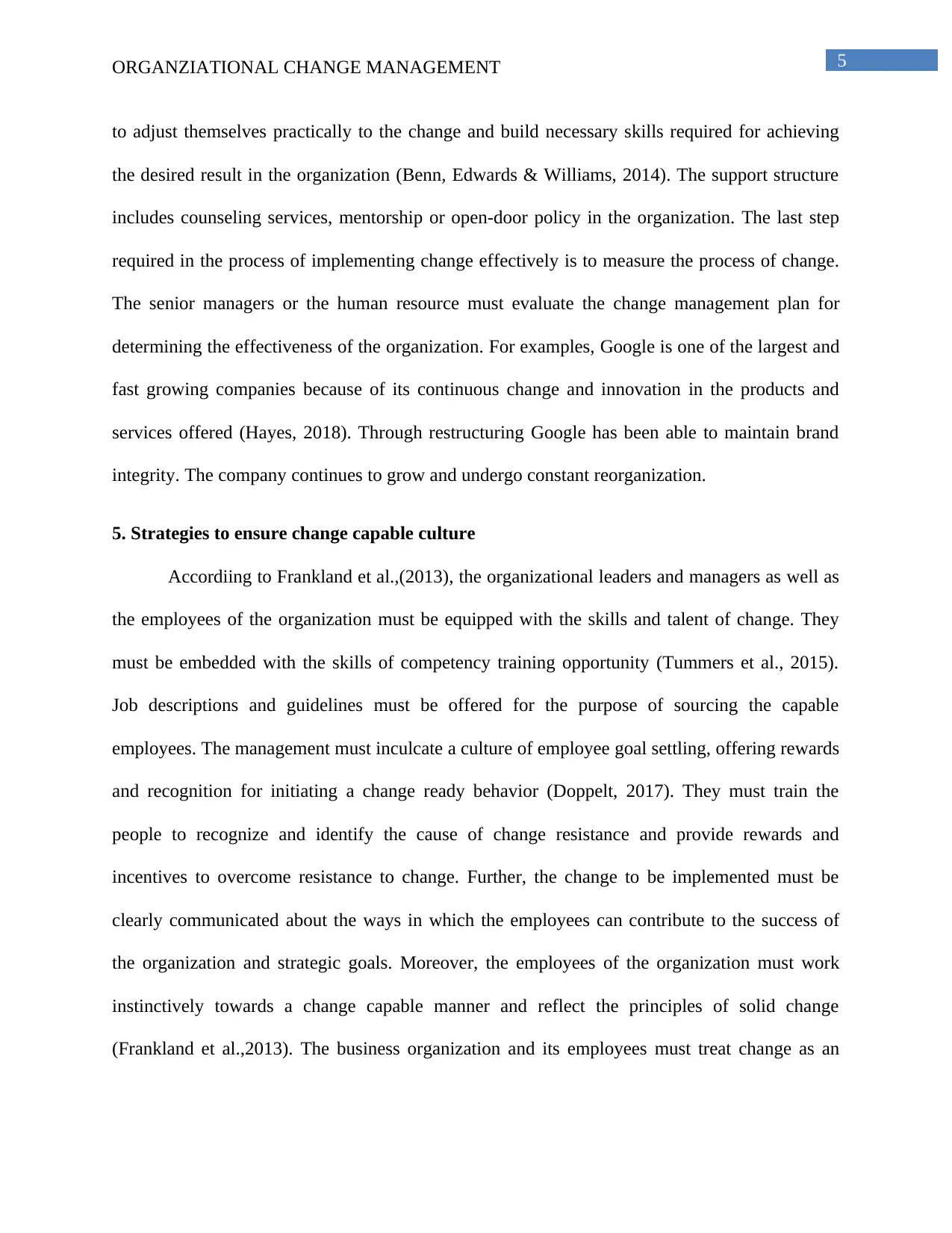
5ORGANZIATIONAL CHANGE MANAGEMENT
to adjust themselves practically to the change and build necessary skills required for achieving
the desired result in the organization (Benn, Edwards & Williams, 2014). The support structure
includes counseling services, mentorship or open-door policy in the organization. The last step
required in the process of implementing change effectively is to measure the process of change.
The senior managers or the human resource must evaluate the change management plan for
determining the effectiveness of the organization. For examples, Google is one of the largest and
fast growing companies because of its continuous change and innovation in the products and
services offered (Hayes, 2018). Through restructuring Google has been able to maintain brand
integrity. The company continues to grow and undergo constant reorganization.
5. Strategies to ensure change capable culture
Accordiing to Frankland et al.,(2013), the organizational leaders and managers as well as
the employees of the organization must be equipped with the skills and talent of change. They
must be embedded with the skills of competency training opportunity (Tummers et al., 2015).
Job descriptions and guidelines must be offered for the purpose of sourcing the capable
employees. The management must inculcate a culture of employee goal settling, offering rewards
and recognition for initiating a change ready behavior (Doppelt, 2017). They must train the
people to recognize and identify the cause of change resistance and provide rewards and
incentives to overcome resistance to change. Further, the change to be implemented must be
clearly communicated about the ways in which the employees can contribute to the success of
the organization and strategic goals. Moreover, the employees of the organization must work
instinctively towards a change capable manner and reflect the principles of solid change
(Frankland et al.,2013). The business organization and its employees must treat change as an
to adjust themselves practically to the change and build necessary skills required for achieving
the desired result in the organization (Benn, Edwards & Williams, 2014). The support structure
includes counseling services, mentorship or open-door policy in the organization. The last step
required in the process of implementing change effectively is to measure the process of change.
The senior managers or the human resource must evaluate the change management plan for
determining the effectiveness of the organization. For examples, Google is one of the largest and
fast growing companies because of its continuous change and innovation in the products and
services offered (Hayes, 2018). Through restructuring Google has been able to maintain brand
integrity. The company continues to grow and undergo constant reorganization.
5. Strategies to ensure change capable culture
Accordiing to Frankland et al.,(2013), the organizational leaders and managers as well as
the employees of the organization must be equipped with the skills and talent of change. They
must be embedded with the skills of competency training opportunity (Tummers et al., 2015).
Job descriptions and guidelines must be offered for the purpose of sourcing the capable
employees. The management must inculcate a culture of employee goal settling, offering rewards
and recognition for initiating a change ready behavior (Doppelt, 2017). They must train the
people to recognize and identify the cause of change resistance and provide rewards and
incentives to overcome resistance to change. Further, the change to be implemented must be
clearly communicated about the ways in which the employees can contribute to the success of
the organization and strategic goals. Moreover, the employees of the organization must work
instinctively towards a change capable manner and reflect the principles of solid change
(Frankland et al.,2013). The business organization and its employees must treat change as an
⊘ This is a preview!⊘
Do you want full access?
Subscribe today to unlock all pages.

Trusted by 1+ million students worldwide
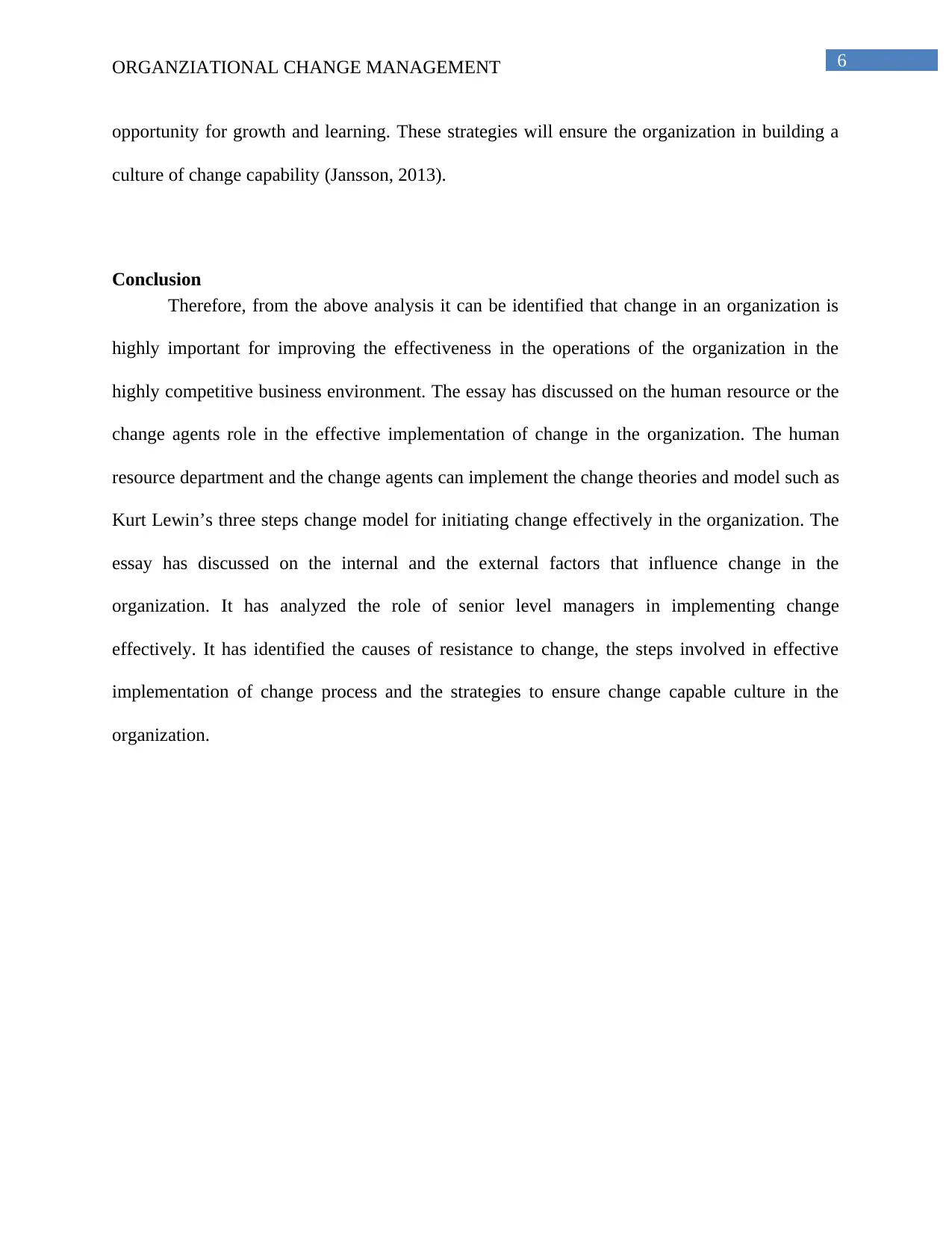
6ORGANZIATIONAL CHANGE MANAGEMENT
opportunity for growth and learning. These strategies will ensure the organization in building a
culture of change capability (Jansson, 2013).
Conclusion
Therefore, from the above analysis it can be identified that change in an organization is
highly important for improving the effectiveness in the operations of the organization in the
highly competitive business environment. The essay has discussed on the human resource or the
change agents role in the effective implementation of change in the organization. The human
resource department and the change agents can implement the change theories and model such as
Kurt Lewin’s three steps change model for initiating change effectively in the organization. The
essay has discussed on the internal and the external factors that influence change in the
organization. It has analyzed the role of senior level managers in implementing change
effectively. It has identified the causes of resistance to change, the steps involved in effective
implementation of change process and the strategies to ensure change capable culture in the
organization.
opportunity for growth and learning. These strategies will ensure the organization in building a
culture of change capability (Jansson, 2013).
Conclusion
Therefore, from the above analysis it can be identified that change in an organization is
highly important for improving the effectiveness in the operations of the organization in the
highly competitive business environment. The essay has discussed on the human resource or the
change agents role in the effective implementation of change in the organization. The human
resource department and the change agents can implement the change theories and model such as
Kurt Lewin’s three steps change model for initiating change effectively in the organization. The
essay has discussed on the internal and the external factors that influence change in the
organization. It has analyzed the role of senior level managers in implementing change
effectively. It has identified the causes of resistance to change, the steps involved in effective
implementation of change process and the strategies to ensure change capable culture in the
organization.
Paraphrase This Document
Need a fresh take? Get an instant paraphrase of this document with our AI Paraphraser
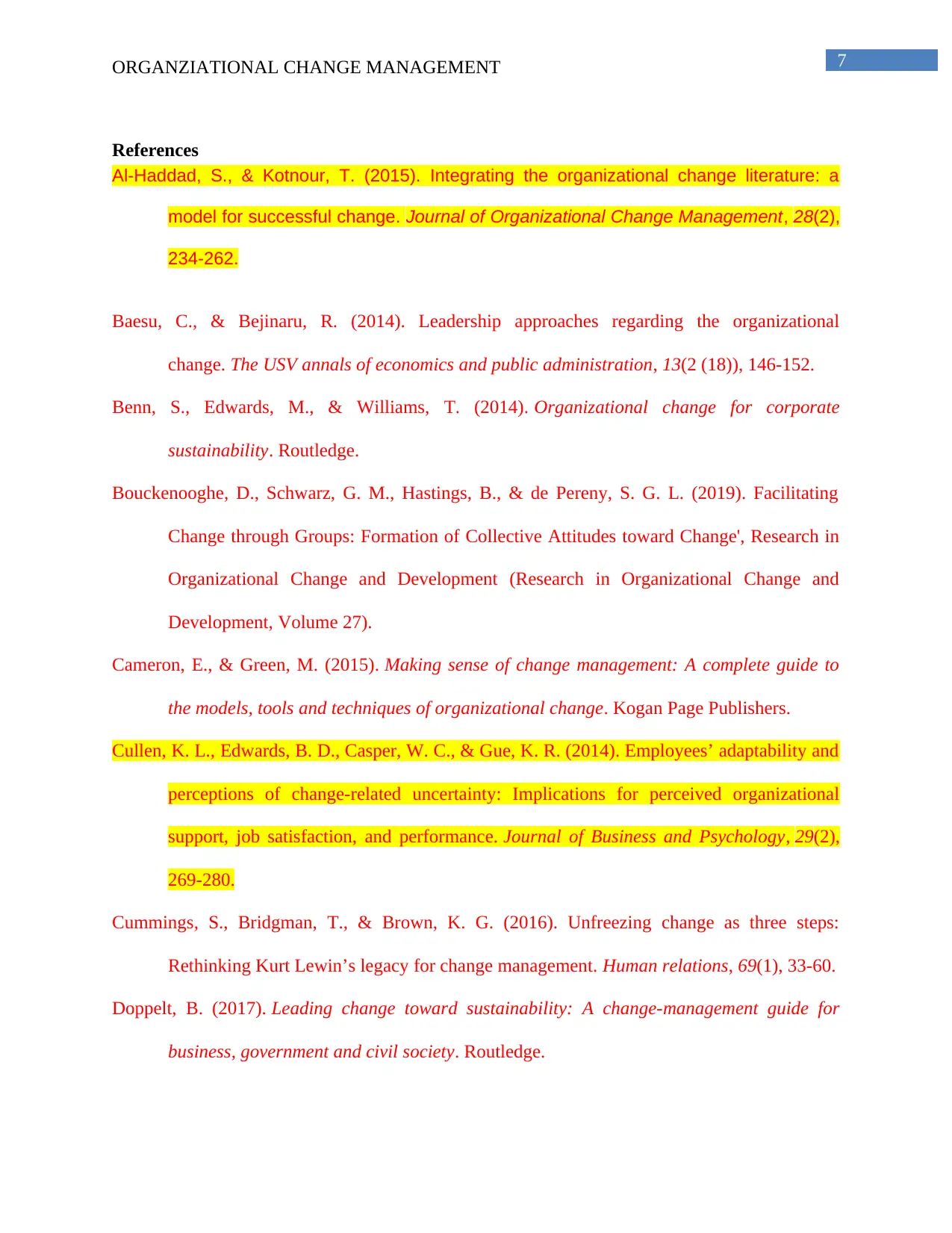
7ORGANZIATIONAL CHANGE MANAGEMENT
References
Al-Haddad, S., & Kotnour, T. (2015). Integrating the organizational change literature: a
model for successful change. Journal of Organizational Change Management, 28(2),
234-262.
Baesu, C., & Bejinaru, R. (2014). Leadership approaches regarding the organizational
change. The USV annals of economics and public administration, 13(2 (18)), 146-152.
Benn, S., Edwards, M., & Williams, T. (2014). Organizational change for corporate
sustainability. Routledge.
Bouckenooghe, D., Schwarz, G. M., Hastings, B., & de Pereny, S. G. L. (2019). Facilitating
Change through Groups: Formation of Collective Attitudes toward Change', Research in
Organizational Change and Development (Research in Organizational Change and
Development, Volume 27).
Cameron, E., & Green, M. (2015). Making sense of change management: A complete guide to
the models, tools and techniques of organizational change. Kogan Page Publishers.
Cullen, K. L., Edwards, B. D., Casper, W. C., & Gue, K. R. (2014). Employees’ adaptability and
perceptions of change-related uncertainty: Implications for perceived organizational
support, job satisfaction, and performance. Journal of Business and Psychology, 29(2),
269-280.
Cummings, S., Bridgman, T., & Brown, K. G. (2016). Unfreezing change as three steps:
Rethinking Kurt Lewin’s legacy for change management. Human relations, 69(1), 33-60.
Doppelt, B. (2017). Leading change toward sustainability: A change-management guide for
business, government and civil society. Routledge.
References
Al-Haddad, S., & Kotnour, T. (2015). Integrating the organizational change literature: a
model for successful change. Journal of Organizational Change Management, 28(2),
234-262.
Baesu, C., & Bejinaru, R. (2014). Leadership approaches regarding the organizational
change. The USV annals of economics and public administration, 13(2 (18)), 146-152.
Benn, S., Edwards, M., & Williams, T. (2014). Organizational change for corporate
sustainability. Routledge.
Bouckenooghe, D., Schwarz, G. M., Hastings, B., & de Pereny, S. G. L. (2019). Facilitating
Change through Groups: Formation of Collective Attitudes toward Change', Research in
Organizational Change and Development (Research in Organizational Change and
Development, Volume 27).
Cameron, E., & Green, M. (2015). Making sense of change management: A complete guide to
the models, tools and techniques of organizational change. Kogan Page Publishers.
Cullen, K. L., Edwards, B. D., Casper, W. C., & Gue, K. R. (2014). Employees’ adaptability and
perceptions of change-related uncertainty: Implications for perceived organizational
support, job satisfaction, and performance. Journal of Business and Psychology, 29(2),
269-280.
Cummings, S., Bridgman, T., & Brown, K. G. (2016). Unfreezing change as three steps:
Rethinking Kurt Lewin’s legacy for change management. Human relations, 69(1), 33-60.
Doppelt, B. (2017). Leading change toward sustainability: A change-management guide for
business, government and civil society. Routledge.
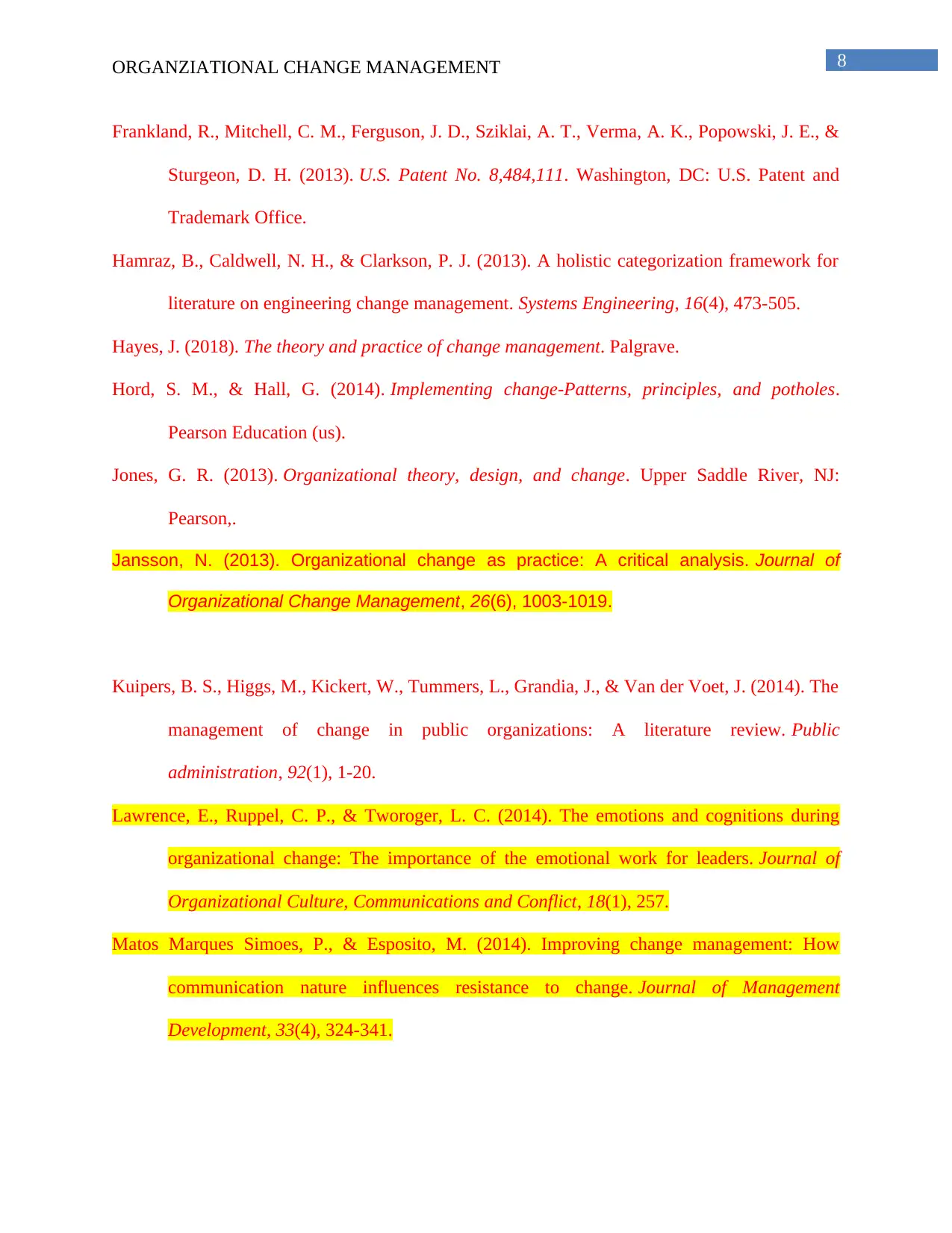
8ORGANZIATIONAL CHANGE MANAGEMENT
Frankland, R., Mitchell, C. M., Ferguson, J. D., Sziklai, A. T., Verma, A. K., Popowski, J. E., &
Sturgeon, D. H. (2013). U.S. Patent No. 8,484,111. Washington, DC: U.S. Patent and
Trademark Office.
Hamraz, B., Caldwell, N. H., & Clarkson, P. J. (2013). A holistic categorization framework for
literature on engineering change management. Systems Engineering, 16(4), 473-505.
Hayes, J. (2018). The theory and practice of change management. Palgrave.
Hord, S. M., & Hall, G. (2014). Implementing change-Patterns, principles, and potholes.
Pearson Education (us).
Jones, G. R. (2013). Organizational theory, design, and change. Upper Saddle River, NJ:
Pearson,.
Jansson, N. (2013). Organizational change as practice: A critical analysis. Journal of
Organizational Change Management, 26(6), 1003-1019.
Kuipers, B. S., Higgs, M., Kickert, W., Tummers, L., Grandia, J., & Van der Voet, J. (2014). The
management of change in public organizations: A literature review. Public
administration, 92(1), 1-20.
Lawrence, E., Ruppel, C. P., & Tworoger, L. C. (2014). The emotions and cognitions during
organizational change: The importance of the emotional work for leaders. Journal of
Organizational Culture, Communications and Conflict, 18(1), 257.
Matos Marques Simoes, P., & Esposito, M. (2014). Improving change management: How
communication nature influences resistance to change. Journal of Management
Development, 33(4), 324-341.
Frankland, R., Mitchell, C. M., Ferguson, J. D., Sziklai, A. T., Verma, A. K., Popowski, J. E., &
Sturgeon, D. H. (2013). U.S. Patent No. 8,484,111. Washington, DC: U.S. Patent and
Trademark Office.
Hamraz, B., Caldwell, N. H., & Clarkson, P. J. (2013). A holistic categorization framework for
literature on engineering change management. Systems Engineering, 16(4), 473-505.
Hayes, J. (2018). The theory and practice of change management. Palgrave.
Hord, S. M., & Hall, G. (2014). Implementing change-Patterns, principles, and potholes.
Pearson Education (us).
Jones, G. R. (2013). Organizational theory, design, and change. Upper Saddle River, NJ:
Pearson,.
Jansson, N. (2013). Organizational change as practice: A critical analysis. Journal of
Organizational Change Management, 26(6), 1003-1019.
Kuipers, B. S., Higgs, M., Kickert, W., Tummers, L., Grandia, J., & Van der Voet, J. (2014). The
management of change in public organizations: A literature review. Public
administration, 92(1), 1-20.
Lawrence, E., Ruppel, C. P., & Tworoger, L. C. (2014). The emotions and cognitions during
organizational change: The importance of the emotional work for leaders. Journal of
Organizational Culture, Communications and Conflict, 18(1), 257.
Matos Marques Simoes, P., & Esposito, M. (2014). Improving change management: How
communication nature influences resistance to change. Journal of Management
Development, 33(4), 324-341.
⊘ This is a preview!⊘
Do you want full access?
Subscribe today to unlock all pages.

Trusted by 1+ million students worldwide
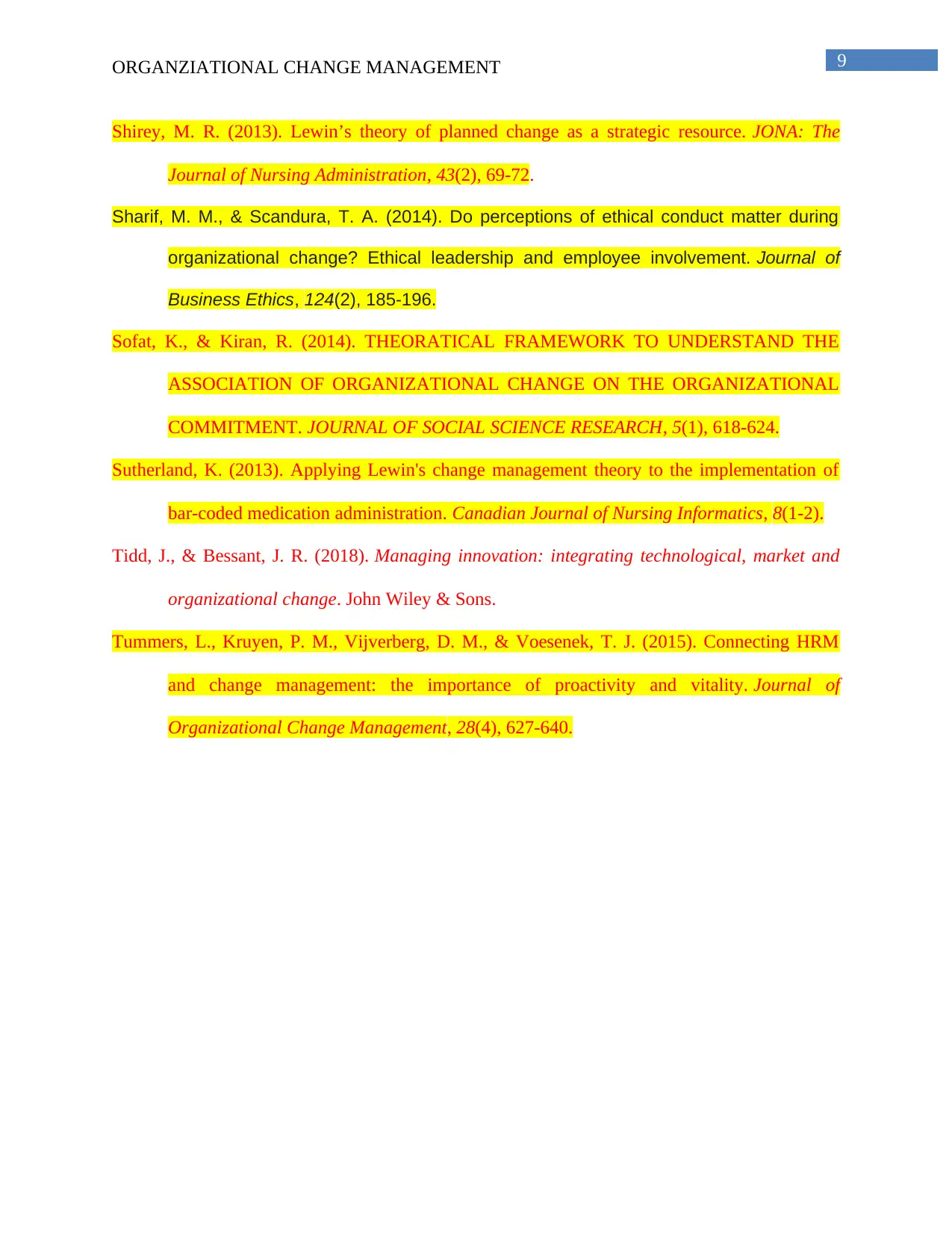
9ORGANZIATIONAL CHANGE MANAGEMENT
Shirey, M. R. (2013). Lewin’s theory of planned change as a strategic resource. JONA: The
Journal of Nursing Administration, 43(2), 69-72.
Sharif, M. M., & Scandura, T. A. (2014). Do perceptions of ethical conduct matter during
organizational change? Ethical leadership and employee involvement. Journal of
Business Ethics, 124(2), 185-196.
Sofat, K., & Kiran, R. (2014). THEORATICAL FRAMEWORK TO UNDERSTAND THE
ASSOCIATION OF ORGANIZATIONAL CHANGE ON THE ORGANIZATIONAL
COMMITMENT. JOURNAL OF SOCIAL SCIENCE RESEARCH, 5(1), 618-624.
Sutherland, K. (2013). Applying Lewin's change management theory to the implementation of
bar-coded medication administration. Canadian Journal of Nursing Informatics, 8(1-2).
Tidd, J., & Bessant, J. R. (2018). Managing innovation: integrating technological, market and
organizational change. John Wiley & Sons.
Tummers, L., Kruyen, P. M., Vijverberg, D. M., & Voesenek, T. J. (2015). Connecting HRM
and change management: the importance of proactivity and vitality. Journal of
Organizational Change Management, 28(4), 627-640.
Shirey, M. R. (2013). Lewin’s theory of planned change as a strategic resource. JONA: The
Journal of Nursing Administration, 43(2), 69-72.
Sharif, M. M., & Scandura, T. A. (2014). Do perceptions of ethical conduct matter during
organizational change? Ethical leadership and employee involvement. Journal of
Business Ethics, 124(2), 185-196.
Sofat, K., & Kiran, R. (2014). THEORATICAL FRAMEWORK TO UNDERSTAND THE
ASSOCIATION OF ORGANIZATIONAL CHANGE ON THE ORGANIZATIONAL
COMMITMENT. JOURNAL OF SOCIAL SCIENCE RESEARCH, 5(1), 618-624.
Sutherland, K. (2013). Applying Lewin's change management theory to the implementation of
bar-coded medication administration. Canadian Journal of Nursing Informatics, 8(1-2).
Tidd, J., & Bessant, J. R. (2018). Managing innovation: integrating technological, market and
organizational change. John Wiley & Sons.
Tummers, L., Kruyen, P. M., Vijverberg, D. M., & Voesenek, T. J. (2015). Connecting HRM
and change management: the importance of proactivity and vitality. Journal of
Organizational Change Management, 28(4), 627-640.
1 out of 10
Related Documents
Your All-in-One AI-Powered Toolkit for Academic Success.
+13062052269
info@desklib.com
Available 24*7 on WhatsApp / Email
![[object Object]](/_next/static/media/star-bottom.7253800d.svg)
Unlock your academic potential
Copyright © 2020–2025 A2Z Services. All Rights Reserved. Developed and managed by ZUCOL.





